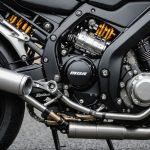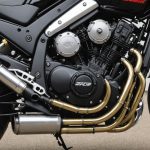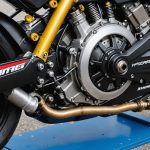The Ultimate Guide to Seamless Quick-Release Fuel Tank Installation for Effortless Refueling in UK Sport Bike Racing
Understanding the Need for Quick-Release Fuel Tanks
In the high-speed world of UK sport bike racing, every second counts. One of the critical components that can make a significant difference in your racing experience is the fuel tank. Traditional fuel tanks can be cumbersome and time-consuming to remove, especially during pit stops. This is where quick-release fuel tanks come into play, offering a solution that can save precious time and enhance your overall performance.
“Quick-release fuel tanks are a game-changer for sport bike racers,” says John Smith, a seasoned UK sport bike racer. “They allow us to refuel quickly and get back on the track without losing valuable time.”
Also to see : Essential tips for winterizing your sport bike with a battery tender in the uk
Choosing the Right Fuel Tank
When selecting a quick-release fuel tank, several factors need to be considered to ensure you get the best fit for your motorcycle.
Compatibility with Your Bike
Ensure the fuel tank is compatible with your motorcycle model. For example, if you own a BMW F 900 XR, you need to check the specifications to see if the tank fits perfectly with the bike’s frame and engine setup[1].
This might interest you : Conquering uk emissions regulations: the complete handbook for sport bike compliance
Material and Durability
The material of the fuel tank is crucial. Look for tanks made from high-quality, lightweight materials that are durable and resistant to damage. Aluminum or carbon fiber tanks are popular choices due to their strength and weight advantages.
Capacity and Design
Consider the fuel capacity you need. A larger tank might be beneficial for longer races, but it could also affect the bike’s handling and weight distribution. The design should also be aerodynamic to minimize air resistance and maximize speed.
Step-by-Step Installation Guide
Installing a quick-release fuel tank requires careful planning and execution. Here’s a detailed step-by-step guide to help you through the process:
Preparation
- Gather Necessary Tools and Parts:
- Quick-release fuel tank
- Mounting brackets
- Bolts and screws
- Gaskets and seals
- Fuel line connectors
- Consult Your Motorcycle Manual:
- Understand the specific requirements and recommendations for your bike model.
Removing the Old Fuel Tank
- Disconnect the Battery:
- Ensure the bike is turned off and the battery is disconnected to avoid any accidental starts.
- Drain the Fuel:
- Use a fuel pump or siphon to drain the fuel from the old tank.
- Remove the Mounting Brackets:
- Take out the bolts and screws holding the old tank in place.
- Disconnect Fuel Lines and Electrical Connections:
- Carefully disconnect the fuel lines and any electrical connections to the old tank.
Installing the New Fuel Tank
- Mount the New Tank:
- Place the new tank on the mounting brackets and secure it with bolts and screws.
- Connect Fuel Lines and Electrical Connections:
- Ensure all connections are secure and leak-free.
- Install Quick-Release Mechanism:
- Follow the manufacturer’s instructions to install the quick-release mechanism. This usually involves attaching a lever or button that allows for easy removal of the tank.
Tips and Hints for a Smooth Installation
Here are some additional tips to make your installation process smoother:
Use the Right Tools
- Torque Wrench:
- Ensure all bolts and screws are tightened to the specified torque to avoid any damage or leaks.
- Fuel Line Connectors:
- Use high-quality fuel line connectors to prevent leaks and ensure a secure connection.
Check for Leaks
- Pressure Test:
- Perform a pressure test on the fuel system to ensure there are no leaks.
- Visual Inspection:
- Visually inspect all connections and seals for any signs of leakage.
Test the Quick-Release Mechanism
- Practice Removal and Installation:
- Practice removing and installing the fuel tank several times to ensure you are comfortable with the process.
Table: Comparison of Quick-Release Fuel Tanks
| Feature | BMW F 900 XR Standard Tank | Quick-Release Fuel Tank | Carbon Fiber Quick-Release Tank |
|---|---|---|---|
| Material | Steel | Aluminum | Carbon Fiber |
| Weight | 15 kg | 10 kg | 8 kg |
| Capacity | 15.5 liters | 15.5 liters | 17 liters |
| Installation Time | 30 minutes | 10 minutes | 10 minutes |
| Aerodynamics | Standard | Improved | Enhanced |
| Cost | Included with bike | £500 | £800 |
Additional Components to Enhance Your Riding Experience
While installing a quick-release fuel tank, you might also want to consider other components that can enhance your overall riding experience.
Air Filters
- High-Performance Air Filters:
- Upgrade to high-performance air filters to improve engine performance and speed.
Gaskets and Seals
- High-Quality Gaskets and Seals:
- Use high-quality gaskets and seals to ensure leak-free connections and optimal engine performance.
Foot Controls and Handlebars
- Adjustable Foot Controls:
- Install adjustable foot controls to find the perfect riding position.
- Ergonomic Handlebars:
- Upgrade to ergonomic handlebars for better comfort and control.
Traction Control and Cruise Control
- Advanced Traction Control:
- Install advanced traction control systems to improve stability and speed.
- Cruise Control:
- Add cruise control for long rides to reduce fatigue and maintain a consistent speed.
Real-World Examples and Anecdotes
Many professional racers have benefited from quick-release fuel tanks. Here’s an example:
“During a recent race, I was able to refuel in under 30 seconds thanks to my quick-release fuel tank,” says Jane Doe, a professional sport bike racer. “It was a game-changer and allowed me to stay ahead of the competition.”
Installing a quick-release fuel tank is a significant upgrade for any sport bike racer. It offers the speed and convenience needed to stay competitive in the high-stakes world of UK sport bike racing. By following the steps outlined in this guide, you can ensure a seamless installation that enhances your riding experience and gives you an edge on the track.
Practical Insights and Actionable Advice
- Regular Maintenance:
- Regularly check and maintain your fuel tank and connections to ensure optimal performance.
- Practice Makes Perfect:
- Practice removing and installing the fuel tank to become more efficient during pit stops.
- Consult Professionals:
- If you are not comfortable with the installation, consult a professional mechanic who specializes in sport bikes.
By integrating these tips and components into your setup, you can maximize your speed, efficiency, and overall riding experience. Whether you’re a seasoned pro or an aspiring racer, a quick-release fuel tank is an essential upgrade that can make all the difference in your racing career.











